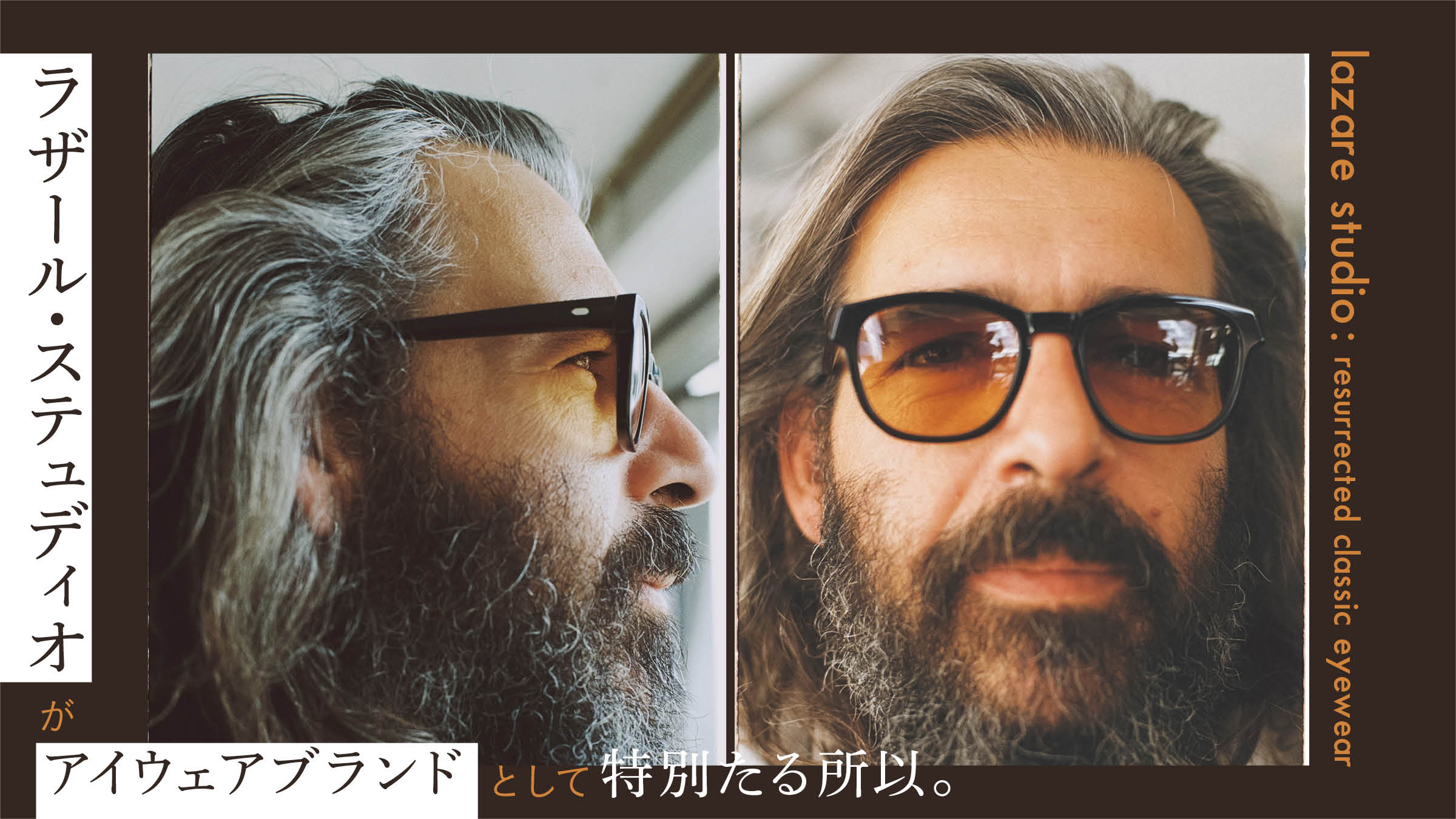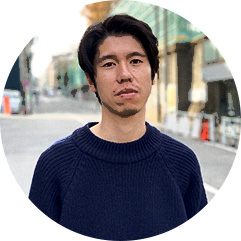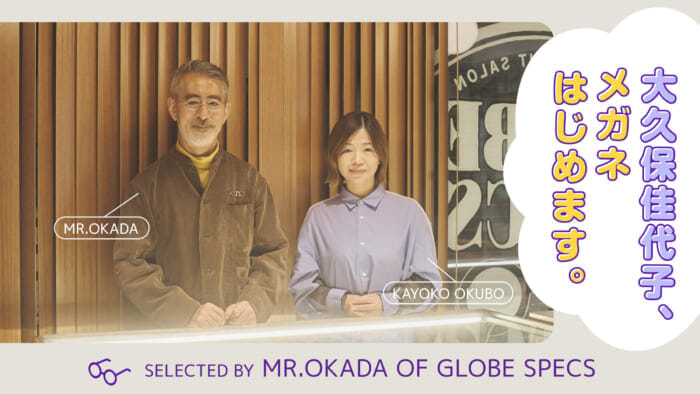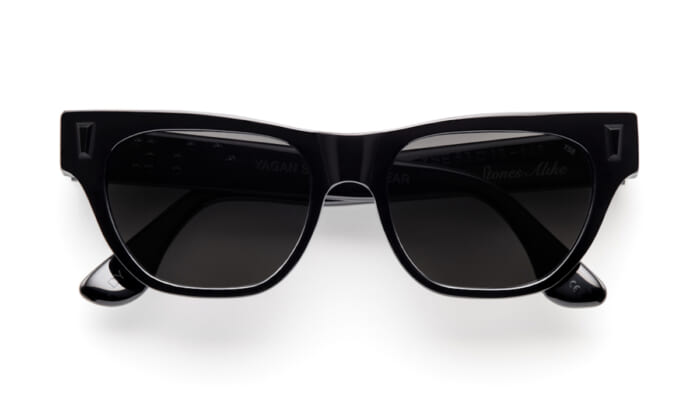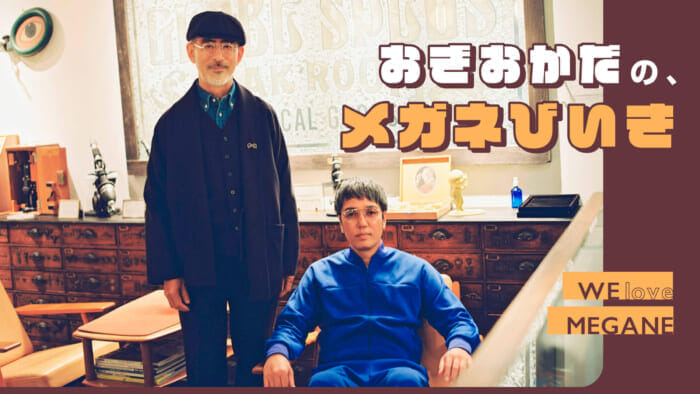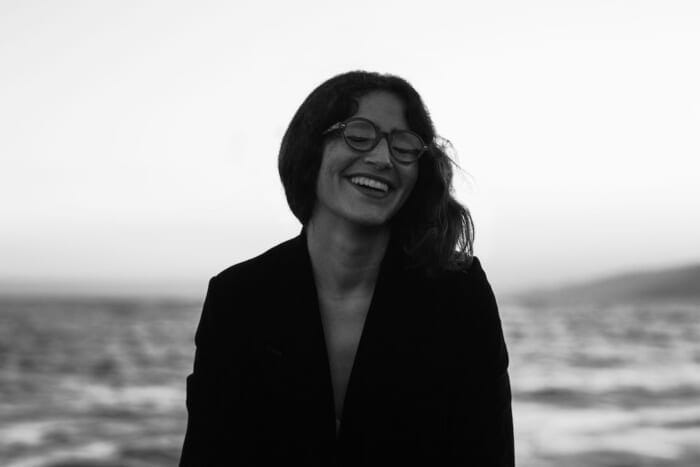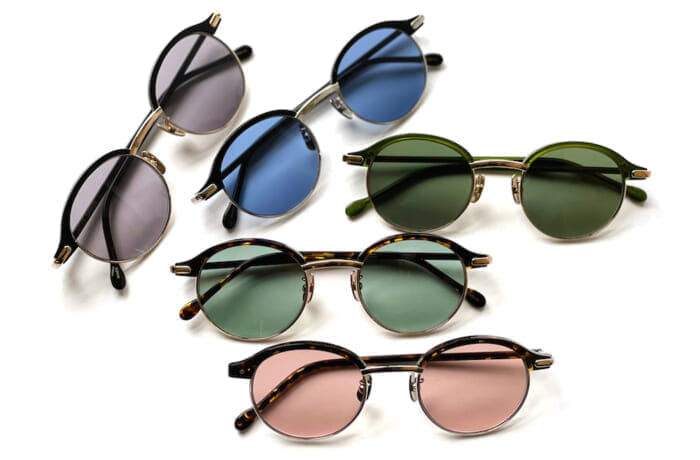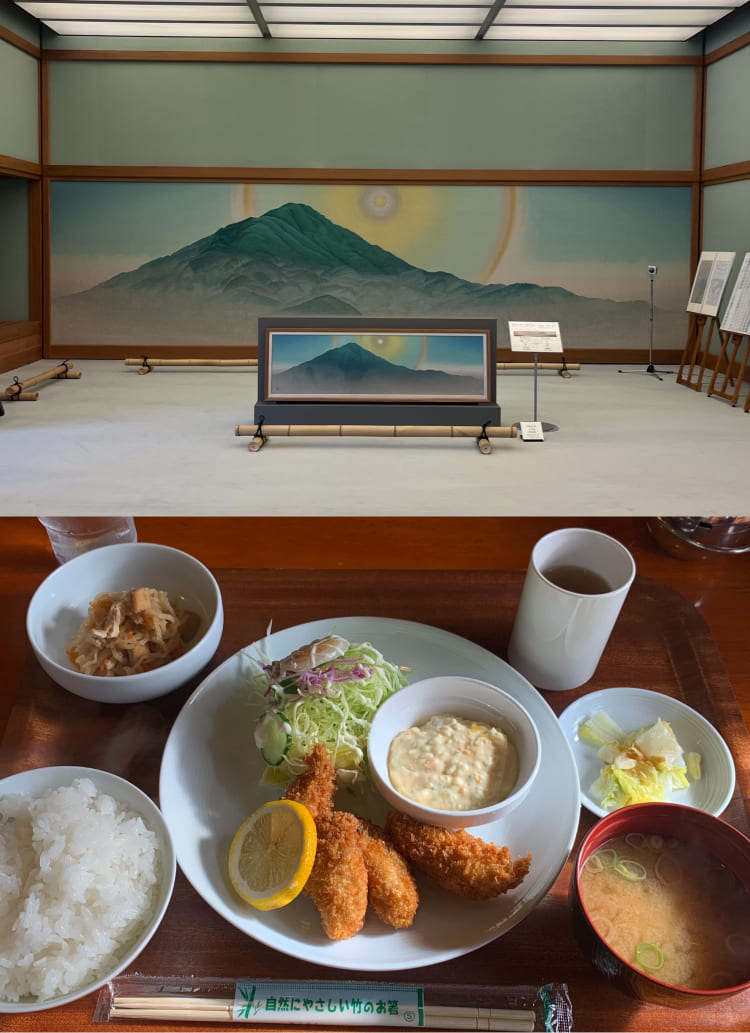Today, we asked Mr. Okada to give us this interview in order to get to know the essence of "Lazare Studio," which he has been enthusiastically promoting. First of all, let's talk about the order session held yesterday at Globespecs. What kind of response did you get there?
Alexandre:First of all, I was impressed by the professionalism of all the store staff. Also, when I met with Japanese customers, I was keenly aware that everyone pays as much attention to the details of eyewear as I do as a designer. I guess this is the Japanese culture. Thanks to the fact that so many people understand the details, I felt that creators like myself can also grow and develop.

Do you feel this is unique to the Japanese audience?
Alexandre:Yes, I think it is very Japanese. There are not many people in Europe who have an attention to detail.
Are you more interested in the overall concept?
Alexandre:Yes, they do pay attention to design and mood first. For example, to understand the appeal of a Japanese brand, one must pay attention to the smallest details. There are many things that cannot be understood at first glance, and you have to actually touch the product to understand it. I think this is because of the Japanese culture, and I am conscious of this way of being when I design.
I was impressed by your blog about the hinge construction, which is a great attention to detail.
Alexandre:Kevlar material (note: a kind of super fiber with extremely high strength, often used in bulletproof vests) is used for acetate frames. For metal frames, we developed special parts made of Teflon® (a type of Teflon® that reduces friction and provides smooth movement) and inserted them inside the hinges to make the opening and closing movements smoother. At first glance, Lazare Studio frames may appear to be classic, but it is these details that set them apart from the rest. We developed the parts uniquely, and many details are packed inside.


Kevlar is a material that is not used for ordinary eyewear, isn't it?
Alexandre:Yes. Friction is no longer generated on the inside of the hinge (hinges), so it does not open and close loosely. Also, in terms of design, the color of the hinge is black to flatten the overall hue.
Is it innate in you to be so conscious of design details?
Alexandre:I don't know about that (laughs). I wasn't taught that by anyone. I am sure that since I was a child, I paid attention to every detail of everything. Even now, I pay attention to details in my daily life. I love things. When I travel, I always carry things that I like. I take the time to choose and use the same things for years to come.

Do you choose your own clothes in the same way?
Alexandre:I like to choose clothes, although I wear only simple designs myself. And I wear them for a long time. I reflect that feeling in my collections. I don't want to make it fast fashion.
Were your parents involved in manufacturing?
Alexandre:No, not at all. My father was a doctor and my mother was a homemaker. But my father always had an eye for detail and seemed to be fascinated by contemporary art and design in general. I remember visiting many museums with my father when I was a child. He also took me to the market every Sunday.
You mean the flea market?
Alexandre:Not a flea market, but a market where you buy vegetables on the street. I have four siblings, but for some reason I was the only one who was taken to the market. My father took his time to carefully select fruits and vegetables one by one. I am sure I learned a lot from watching his back. Nowadays, there are not many people in France who go to the market on a regular basis.
Did the city of Lyon, where you were born and raised, have any influence on your work?
Alexandre:There may be. Lyon has two sides to it, one is the modern city and the other is the old town. It is truly an antique city, with buildings that are 2000 years old still standing.


Do you feel attached to this history and the past?
Alexandre:No, rather, I have always been fascinated by the contrast between the past and the future, what I call retro-futurism. in the 20th century, eyewear was deeply studied and all kinds of shades and shapes were developed. if you go back to the 19th century or earlier, all frames were medical tools, so the shapes were round or oval. But around 1910 or 1920, people started looking for ways to make people more beautiful with eyeglasses.
What significance do you find in citing the past to create something new?
Alexandre:We inherit the past and look for new ways to enhance it. On the other hand, there are some things in the world that have always been made in the traditional way. Of course, that is fine. However, the goal of many products nowadays is too much to "just make it fast. In such a situation, traditional manufacturing should be reemphasized. For example, in terms of shape, everything that is considered elegant was created between the 1920s and 1940s. That is why this brand has given frames a new look while retaining the excellent balance of the past. In other words, the Lazare Studio collection is based on classic shapes, but they are given a more modern touch.

The "early 30's" shape is combined with an X-Bridge from the 19th century. The aged coloring is influenced by the Japanese wabi-sabi spirit. The X-Bridge detailing accents the frame with a modern touch.

The shape is based on the classic frames of the 70's." ¥75900 The shape is based on the classic frames of the 70's." ¥75,900
Could you tell us your definition of the word "modern"?
Alexandre:Modern to me means being in and living with the times. What is modern about my frames? For example, the hinge technology, which is modern. I incorporate cutting-edge technology and materials to create modern products in the modern age. The degree of grinding of the frame is neither too round nor too polished. The edges of old frames are rounded off considerably during the polishing process, and we wanted to keep that touch.
I see...it is a perfect balance.
Alexandre:That's right. Tumbling (note: the process of polishing the surface by placing the assembled frame and abrasive together in an octagonal drum and rotating it) has changed from the past, and the edges of today's eyewear are finished at a sharp angle. However, we have adopted some of the finishes of the old process to express the nuances of the past.
Do you mean that you mix both cutting-edge technology and traditional processes and specifications?
Alexandre:Exactly. At the same time, we use components manufactured in Japan, so we are mixing cultures. There are only four countries that make frames in the traditional way: France, Germany, Italy, and Japan. Even in the U.S., which produced many masterpieces, frames are no longer made in this way. There are also differences in the process and the way of thinking about details between Japan and France. That is why we try to make frames by mixing both cultures.


The materials are futuristic and the design is traditional. This is a slightly masculine design, but I think it can be worn for any occasion." ¥92,400
Regarding the cultural differences between France and Japan, do you think there are similar differences in the way eyewear is accepted?
Alexandre:I think things have changed somewhat now, but in the past, eyewear with a colorful appearance was preferred in France, or to put it another way, eyewear that did not pay attention to details was chosen. However, as Japanese brands began to be imported to France, French people began to pay attention to details. Incidentally, before I launched my own brand, I ran an eyeglasses store in France, where I sold many Japanese brands.
Was the decision to use Japanese components a part of the brand's founding?
Alexandre:For parts, we must say that Japanese manufacturers are the best. The quality of the manufacturing process and the precision of the molds are the highest anywhere in the world.
Why did you choose the field of eyewear in the first place?
Alexandre:When I was young, I wanted to be an architect, but one day a friend told me about opticians. There, I was impressed by the craziness of eyewear, a small product that people need on a daily basis, filled with various technologies and designs. People wear eyeglass frames from morning to night. I thought that I could also deliver something to people through this product.

That's a very simple explanation. Now that I have a better understanding of what the Lazare Studio brand values in its products and how it perceives the appeal of eyewear, I would like to ask you about the relationship between eyewear and fashion. Next, I would like to ask you about the relationship between eyewear and fashion. What influences you in terms of image?
Alexandre:This is already clear: it's a movie. I have seen thousands of movies. I still watch at least one movie every day. Old movies, new movies, everything. I see film as a way to travel into the past and into the future. I think a filmmaker who has a lot of ideas is an artist in the true sense of the word.
Yes, I agree.
Alexandre:Take, for example, the "Juliet" frame. The name of this model is taken from Juliette Bruce in "The Blues Brothers" (released in 1980, directed by John Landis). Or there is a frame that borrows its name from the character Mirta Jung, played by Penelope Cruz in "Blow" (released in 2001, directed by Ted Demme).

I'm thinking of classic frames from the 50's, especially the Wayfarer shape. This is the Juliet model I mentioned earlier. If you look closely, you can see marbles mixed into the frame, which we call a candy pattern.
So, you mean that the starting point of your design is the eyewear worn by the characters in the film?
Alexandre:No, we do not design frames from movies. Once I design a frame, I look for a movie that has a character wearing something similar to that frame. In that sense, I don't get inspiration directly from the film itself. In other words, I don't watch a movie and think, "Okay, I'll make this frame. My inspiration is always in my head or in my mood.
I see what you mean.
Alexandre:I simply take pleasure in the act of borrowing names from movies I love, and in fact, it is not that important in my collection. What is important to me is only design and quality. To that end, I draw a large number of frames every day, and when I think, "This could be an interesting design," I balance the shapes over and over again. Then I make prototypes and try the frames on various people's faces to achieve the balance that I think is best.

You mentioned earlier that you interpret film as "a journey into the past or the future." Would you say that you draw inspiration from various eras through film?
Alexandre:That is certainly true. Especially in the 20th century, a new style was developed every decade. Fashion during this period underwent dizzying changes: each decade from the 1910s to the 1980s had a completely different mood and design. My designs are a mixture of all these elements. The same is true of the male and female figures. Nowadays, it is normal for women to wear men's frames or for men to wear women's frames.
Are there any particular years in particular that stand out in your mind?
Alexandre:When it comes to the image of women, I admire the glamour of the 1970s, a time when new minds, new fashions, and new designs were being developed, a bit removed from the traditional. In that sense, I think it was really creative. In terms of eyewear design, the 20's, when round and oval frames were the standard, are special to me. I can say with certainty that those shapes are still perfect over time.

The shape is reminiscent of the glamorous style of the 1970s. Please take note of the precise and unmatched cutting of the frame." ¥58,300
When I listened to you today, I got the impression that you not only reinterpret the past, but also express the memories of various eras replayed in your brain through the "Lazare Studio" collection.
Alexandre:Exactly! I like the phrase "future memory" and I'm glad you take it that way. In my case, I don't try hard to discover any new ideas, I really just come up with them. As for my design philosophy, I don't want to just cut shapes out of people I see on the street or old photos and recreate antique frames.
In the fashion world, it is common practice to reproduce designs picked from "Pinterest" or "Instagram. While I can't deny the lightness of this practice, I was still somewhat bothered by it, so what you just said made me think twice.
Alexandre:(Do you know the story of Lazar (the origin of the brand name)? In the Bible, Lazar is the only person to be resurrected from the dead. I am trying to "resurrect" classic shapes in my collection. By creating new frames and new concepts based on traditional shapes, I am taking on the past. However, I am not recreating the past.
That is an important point.
Alexandre:Yes. What I want to do is to reinvent the past.

When I started working as an optician, there were not as many stores like Globespecs that specialized in traditional and designer eyewear from all over the world. When I went to Japan for the first time, my main purpose was to visit Globespecs, which was a pioneer in the world. That is why I felt very honored when Mr. Okada, the representative of Globespecs, decided to carry Lazare Studios.
- 1
- 2


